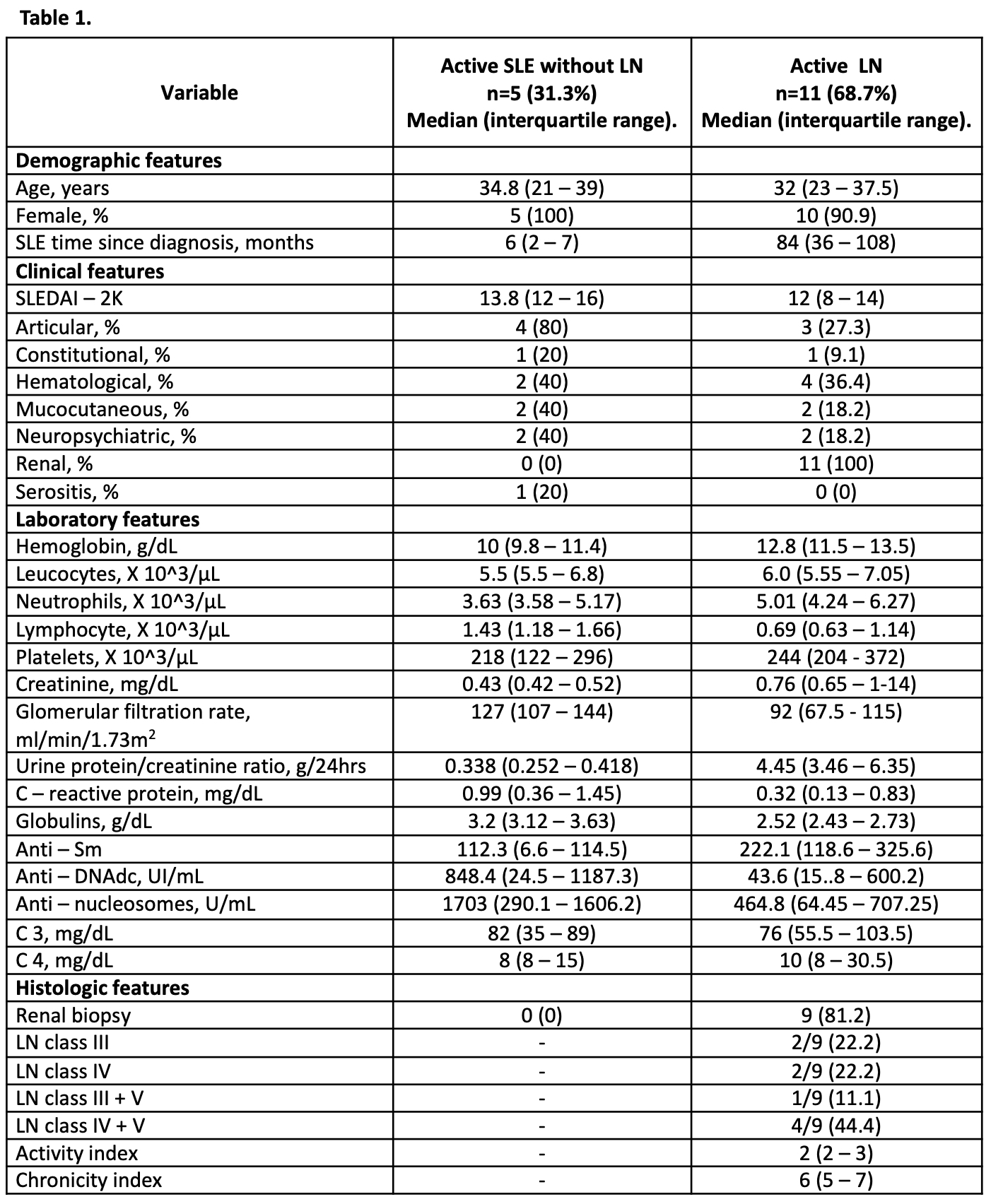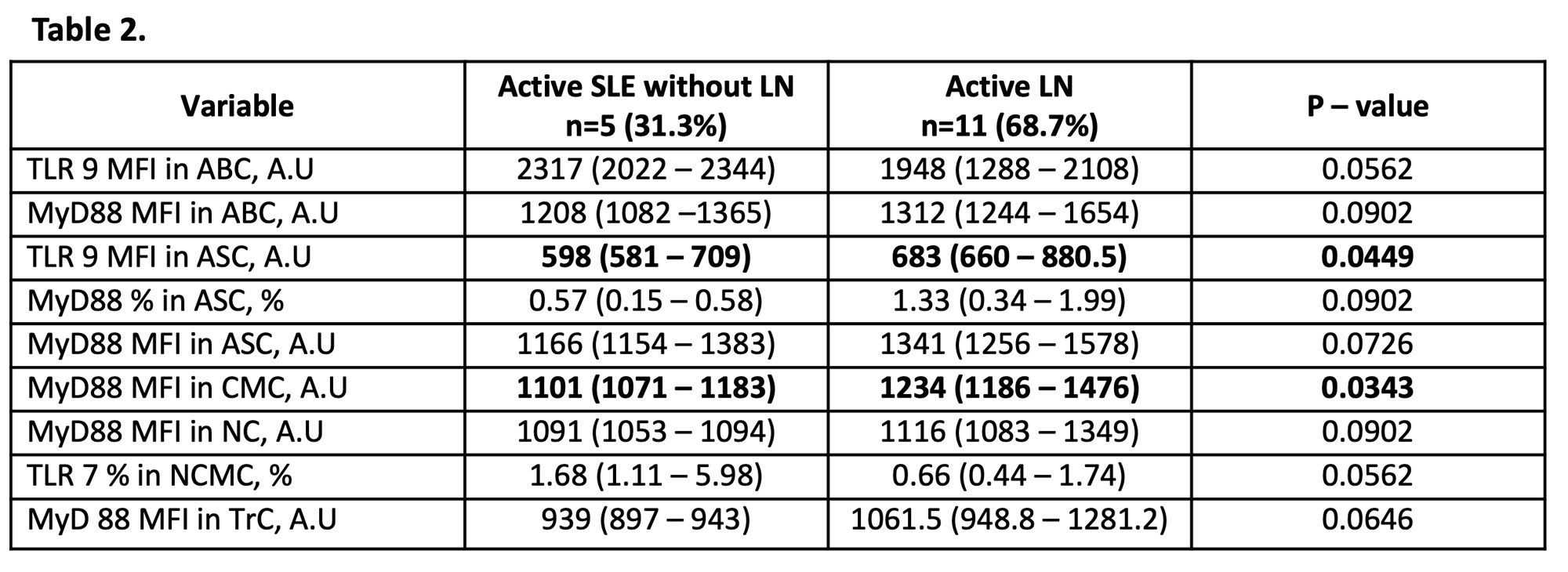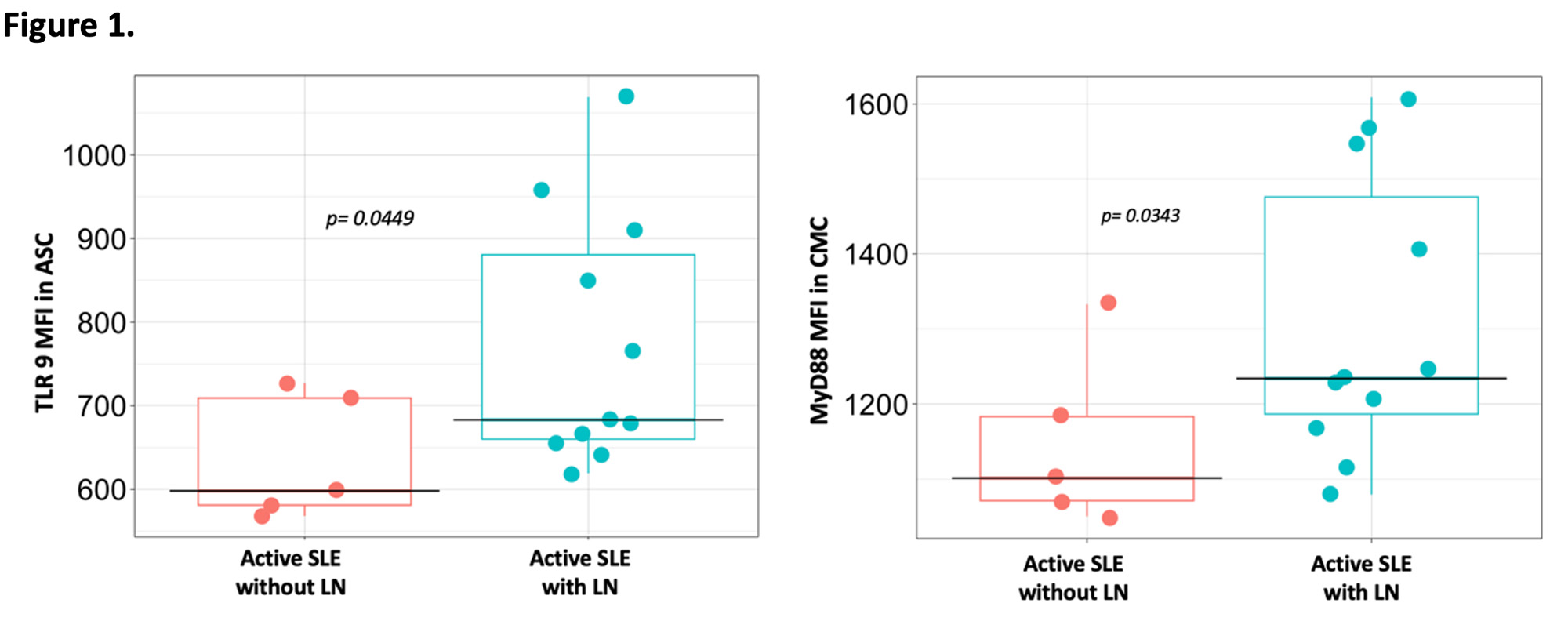Session Information
Date: Sunday, November 12, 2023
Title: (0543–0581) SLE – Diagnosis, Manifestations, & Outcomes Poster I
Session Type: Poster Session A
Session Time: 9:00AM-11:00AM
Background/Purpose: Intrinsic signaling of intracytoplasmic TLRs (7 and 9) and MyD88 in B cells (BC) plays an important role in the development and pathogenesis of Systemic Lupus Erythematosus (SLE). Different genetic polymorphisms of TLR7 and TLR9 have been associated with the development of lupus nephritis (LN). In patients with SLE there is a higher expression of TLRs 7, 9 and MyD88 in their peripheral blood mononuclear cells (PBMCs) compared to healthy subjects. There is scarce information about the expression of TLR7, 9 and MyD88 in B cell subsets in patients with LN.
We aimed to analyze the expression of intracytoplasmic TLRs (7 and 9) and MyD88 in different subsets of BC from patients with lupus nephritis.
Methods: We included adult patients who fulfilled the ACR/SLICC 2012 classification criteria for SLE. They were stratified in 2 groups: those who had active LN (cases) proven by renal biopsy (LN class III/IV +/- V) or laboratory parameters (decreased filtration rate, proteinuria >500mg/24 hours or active urinary sediment) and those with active SLE (SLEDAI 2K: ³6) but without renal involvement for the last 5 years (controls). Exclusion criteria included prior treatment with anti CD20 drugs.
Using multiparametric flow cytometry we measured the expression of TLRs 7, 9 and MyD88 in BC subsets from a peripheral blood sample. The BC subsets evaluated were: age-associated B cells (ABC) [CD19posCD21neg/lo CD11chi Tbet pos], antibody-secreting cells (ASC) [CD19pos CD27hi CD38hi], classic memory cells (CMC) [CD19pos CD27pos IgD pos/neg], double negative cells (DNC) [CD27neg IgD neg], naive cells (NC), non classic memory cells (NCMC) [CD27 neg] and transitional cells (TrC) [CD21 neg/lo ]. All samples were acquired in a BD LSR Fortessa flow cytometer and data were analyzed by support of the flow jo software.
Absolute cell numbers and percentage of cells positive for TLR7, 9 and MyD88 expression was measured as well as mean fluorescence intensity (MFI) for each molecule in each of the B cell subset assessed. Comparisons were made between groups by using the Mann–Whitney U test.
Results: A total of 16 patients with active SLE were included. Eleven of them (68.7%) were assigned as cases (with LN) and 5 of them (31.3%) as controls (without LN). The majority (93.8%) were women. Their main demographic, clinical and laboratory features are depicted in Table 1.
In general, we observed increased expression of TLR 9 and MyD88 in BC subsets from patients with lupus nephritis than those without renal involvement (Table 2). Particularly, we found enhanced TLR 9 expression (MFI) in antibody-secreting cells (ASC) [active SLE with LN: 683 A.U (660 – 880.5), active SLE without LN: 598 A.U (581 – 709); p=0.0449], as well as higher MyD88 expression (MFI) in classic memory cells (CMC) [active SLE with LN: 1234 A.U (1186 – 1476), active SLE without LN: 1101 A.U (1071 – 1183); p=0.0343]. This information is reflected on the boxplots below (Figure 1).
Conclusion: Our preliminary data suggests that patients with lupus nephritis are characterized by enhanced expression of TLR 9 and MyD88 in specific B cell subsets, particularly of the effector humoral compartment, which might be involved in the pathogenesis of renal damage in SLE.
Data are expressed as median (interquartile range).
To cite this abstract in AMA style:
Loeza-Uribe M, Espinoza-Carranza M, Reyna-Juárez Y, Alcalá-Carmona B, Mejía-Domínguez N, Juárez-Vega G, Maravillas-Montero J, Santana-de Anda K, Torres-Ruiz J, Gómez-Martín D. Analysis of Intracytoplasmic Toll – Like Receptors (TLRs) and MyD88 Expression in B Cell Subsets in Patients with Lupus Nephritis [abstract]. Arthritis Rheumatol. 2023; 75 (suppl 9). https://acrabstracts.org/abstract/analysis-of-intracytoplasmic-toll-like-receptors-tlrs-and-myd88-expression-in-b-cell-subsets-in-patients-with-lupus-nephritis/. Accessed .« Back to ACR Convergence 2023
ACR Meeting Abstracts - https://acrabstracts.org/abstract/analysis-of-intracytoplasmic-toll-like-receptors-tlrs-and-myd88-expression-in-b-cell-subsets-in-patients-with-lupus-nephritis/



